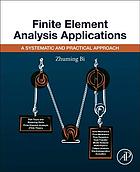

Most ebook files are in PDF format, so you can easily read them using various software such as Foxit Reader or directly on the Google Chrome browser.
Some ebook files are released by publishers in other formats such as .awz, .mobi, .epub, .fb2, etc. You may need to install specific software to read these formats on mobile/PC, such as Calibre.
Please read the tutorial at this link: https://ebookbell.com/faq
We offer FREE conversion to the popular formats you request; however, this may take some time. Therefore, right after payment, please email us, and we will try to provide the service as quickly as possible.
For some exceptional file formats or broken links (if any), please refrain from opening any disputes. Instead, email us first, and we will try to assist within a maximum of 6 hours.
EbookBell Team

4.8
44 reviewsThis work strikes a solid balance between more traditional FEA textbooks that focus primarily on theory, and the software specific guidebooks that help teach students and professionals how to use particular FEA software packages without providing the theoretical foundation. Professor Bi condenses the introduction of theories and focuses mainly on essentials that students need to understand FEA models. The book is organised to be application-oriented, covering FEA modelling theory and skills directly associated with activities involved in design processes. Discussion of classic FEA elements (such as truss, beam and frame) is limited.
Abstract: Annotation
This work strikes a solid balance between more traditional FEA textbooks that focus primarily on theory, and the software specific guidebooks that help teach students and professionals how to use particular FEA software packages without providing the theoretical foundation. Professor Bi condenses the introduction of theories and focuses mainly on essentials that students need to understand FEA models. The book is organised to be application-oriented, covering FEA modelling theory and skills directly associated with activities involved in design processes. Discussion of classic FEA elements (such as truss, beam and frame) is limited